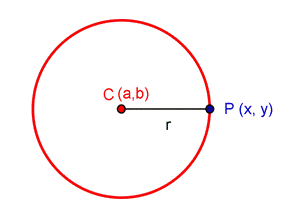We will call the circumference: the geometric locus of points on the plane that are equidistant to a fixed point called center. This distance is named radius.
This property is the key to finding the analytical expression of a circumference.
Let's see it:
A circumference of center
Expressing this in a mathematical equation we have:

Example
When we consider a circumference centred on the origin, we are taking
Example
The circumference with center in the origin and radius
Example
If, for example, we want to write the equation of a circumference centred at point
We calculate the radius:
We replace the parameters in the equation of the circumference, with
